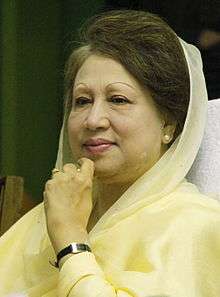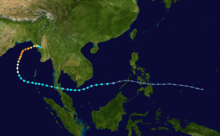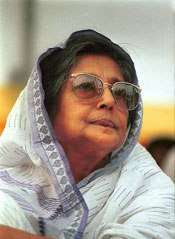1992 in Bangladesh
1992 (MCMXCII) was a leap year starting on Wednesday of the Gregorian calendar, the 1992nd year of the Common Era (CE) and Anno Domini (AD) designations, the 992nd year of the 2nd millennium, the 92nd year of the 20th century, and the 3rd year of the 1990s decade.
| |||||
| Centuries: |
| ||||
|---|---|---|---|---|---|
| Decades: |
| ||||
| See also: | Other events of 1992 List of years in Bangladesh | ||||
The year 1992 was the 21st year after the independence of Bangladesh. It was also the second year of the first term of the Government of Khaleda Zia.
Incumbents

Zia
Demography
| Population, total | 111,221,938 |
| Population density (per km2) | 854.4 |
| Population growth (annual %) | 2.3% |
| Male to Female Ratio (every 100 Female) | 104.4 |
| Urban population (% of total) | 20.6% |
| Birth rate, crude (per 1,000 people) | 33.5 |
| Death rate, crude (per 1,000 people) | 9.5 |
| Mortality rate, under 5 (per 1,000 live births) | 131.7 |
| Life expectancy at birth, total (years) | 59.7 |
| Fertility rate, total (births per woman) | 4.1 |
Climate
| Climate data for Bangladesh in 1992 | |||||||||||||
|---|---|---|---|---|---|---|---|---|---|---|---|---|---|
| Month | Jan | Feb | Mar | Apr | May | Jun | Jul | Aug | Sep | Oct | Nov | Dec | Year |
| Daily mean °C (°F) | 17.5 (63.5) |
19.2 (66.6) |
25.3 (77.5) |
28.3 (82.9) |
27.4 (81.3) |
28.4 (83.1) |
27.7 (81.9) |
28.1 (82.6) |
27.8 (82.0) |
26.5 (79.7) |
23. (73) |
18.3 (64.9) |
24.8 (76.6) |
| Average precipitation mm (inches) | 5.3 (0.21) |
45. (1.8) |
15.9 (0.63) |
43.4 (1.71) |
197. (7.8) |
280. (11.0) |
487.2 (19.18) |
329.1 (12.96) |
309.6 (12.19) |
145.4 (5.72) |
8.5 (0.33) |
3.5 (0.14) |
1,869.9 (73.62) |
| Source: Climatic Research Unit (CRU) of University of East Anglia (UEA)[2] | |||||||||||||
Cyclone

A powerful tropical cyclone, named Cyclone Forrest prompted the evacuation of 600,000 people in Bangladesh in late November 1992. Originating from an area of disturbed weather near the Caroline Islands on 9 November, Forrest was classified as a tropical depression three days later over the South China Sea. Tracking generally west, the system steadily organized into a tropical storm, passing Vietnam to the south, before striking Thailand along the Malay Peninsula on 15 November. Once over the Bay of Bengal, Forrest turned northward on 17 November and significantly intensified. It reached its peak intensity on 20 November as a Category 4-equivalent cyclone on the Saffir–Simpson hurricane scale with winds of 230 km/h (145 mph). Hostile environmental conditions soon affected the cyclone as it turned abruptly east-northeastward. Forrest made landfall in northwestern Myanmar as a weakening system on 21 November before dissipating early the next day.[3]
On 20 November, as Forrest reached its peak intensity, fears arose across Bangladesh that a repeat of the catastrophic April 1991 cyclone would take place. As a result, mass evacuation plans were enacted across coastal areas of the country, with plans to relocate up to 2 million people. But the storm abruptly turned eastward, and the successful evacuation of 600,000 residents spared countless lives. Only two deaths were recorded and overall damage was light, though half of all homes on St. Martin's Island were damaged.[3]
Economy
| National Income | |||
|---|---|---|---|
| Current US$ | Current BDT | % of GDP | |
| GDP | $31.7 billion | BDT1,195.4 billion | |
| GDP growth (annual %) | 5.4% | ||
| GDP per capita | $285.1 | BDT10,748 | |
| Agriculture, value added | $9.0 billion | BDT339.4 billion | 29.4% |
| Industry, value added | $6.9 billion | BDT259.6 billion | 22.5% |
| Services, etc., value added | $14.7 billion | BDT556.0 billion | 48.1% |
| Balance of Payment | |||
| Current US$ | Current BDT | % of GDP | |
| Current account balance | $180.8 million | .6% | |
| Imports of goods and services | $4,142.6 million | BDT147.6 billion | 12.3% |
| Exports of goods and services | $2,581.2 million | BDT90.7 billion | 7.6% |
| Foreign direct investment, net inflows | $3.7 million | 0.0% | |
| Personal remittances, received | $911.8 million | 2.9% | |
| Total reserves (includes gold) at year end | $1,853.5 million | ||
| Total reserves in months of imports | 5.2 | ||
Note: For the year 1992 average official exchange rate for BDT was 38.95 per US$.
Events

- 26 March – The Ghatak-Dalal Nirmul Committee set up mock trials known as Gono Adalat (People's Court) led by Jahanara Imam in Dhaka and 'sentenced' persons they accused of being war criminals.[4]
- 10 April – The Logang Massacre took place in Logang village in the Khagrachari District along the border with India. The massacre allegedly involved Bengali civilians, border guards, and the army who attacked the Jumma people with axes, hatchets, and guns, burning down all the houses.[5] The government investigation committee announced that only 12 people have died, while the unofficial estimate puts the death-toll to around 400.[6]
- 21 October – The Bangladesh Open University was established with its main campus in Board Bazar, Gazipur District, Dhaka Division.[7]
- 7 December – There were a series of violence against the Bengali Hindus in protest against the demolition of Babri Masjid and violence against Muslims in India. the Dhakeshwari temple was attacked. The Bholanath Giri Ashram in Dhaka was attacked and looted.[8] Hindu owned jewellery shops were looted in old Dhaka. Hindu houses in Rayerbazar were set on fire.[9]
- 8 December – Hindus were attacked in Kutubdia Upazila in Cox's Bazar District. Muslims attacked 14 Hindu temples, eight of them were burnt and six damaged. 51 Hindu houses in Ali Akbar Dale and another 30 in Choufaldandi.[10]
- A third of the 250,000 Rohingyas of Burma flee into Bangladesh.[11]
Awards and recognitions
- Gonoshasthaya Kendra / Zafrullah Chowdhury was awarded the Right Livelihood Award.
Sports
- Olympics:
- Bangladesh sent a delegation to compete in the 1992 Summer Olympics in Barcelona, Spain. Bangladesh did not win any medals in the competition.
- Domestic football:
- Abahani KC won Dhaka League title while Mohammedan SC came out runner-up.[12]
- Cricket:
- The 1992–93 SAARC Quadrangular cricket Tournament started in Dhaka, Bangladesh in December 1992 amidst great enthusiasm and excitement. 4 teams, the 'A' teams from neighbouring India, Pakistan and Sri Lanka, and the full national team of the host country participated in the event. Due to the volatile political situation arising in the sub-continent, the tournament had to be abandoned at the League stage. Thus, there was no winners of the tournament.
Births
- 7 February – Taijul Islam, cricketer[13]
- 5 August – Abul Hasan, cricketer[14]
- 24 October – Pori Moni, actor
- 17 December – Asif Ahmed, cricketer[15]
- 16 December – Anamul Haque, cricketer
Deaths
- 29 April – Ghulam Faruque Khan, Governor of East Pakistan (b. 1899)[16]
References
- "World Development Indicators". The World Bank. Retrieved 27 May 2018.
- "Climate Change Knowledge Portal". The World Bank Group. Retrieved 27 May 2018.
- Gregory Salvato (1993). "Typhoon Forrest (30W)". Annual Tropical Cyclone Report (PDF). Joint Typhoon Warning Center (Report). United states Navy. pp. 141–144. Retrieved 24 May 2014.
- "Jahanara Imam's death anniversary today". New Age. Retrieved 9 March 2016.
- "チッタゴン丘陵問題とはどういう問題か". thirdculture.com. Retrieved 15 July 2018.
- "Establishment of All India Muslim League". Story Of Pakistan. 1 June 2003. Retrieved 15 July 2018.
- Heidelberg Bangladesh Law Translation Project: Bangladesh Open University Act, 1992 (URL last accessed on 30 April 2007)
- Amor, Abdelfattah (20 January 1994). "Application de la Declaration sur l'Elimination de toutes le formes d'Intolerance et de Discrimination Fondees sur la Religion ou la Conviction". Vietnam Human Rights Network. Retrieved 5 October 2012.
- Kemp, Jeff (2004). Make or Break: Bangladesh in the 1990s. Edinburgh: Lame Duck Press. p. 13. ISBN 1-904896-02-2.
- Sarkar, Bidyut (1993). Bangladesh 1992 : This is our home : Sample Document of the Plight of our Hindu, Buddhist, Christian and Tribal Minorities in our Islamized Homeland : Pogroms 1987-1992. Bangladesh Minority Hindu, Buddhist, Christian, (and Tribal) Unity Council of North America. p. 67.
- Thompson, Mike (11 March 2006). "Burma's forgotten Rohingya". BBC News.
- "List of Champions". Atsushi Fujioka for Rec.Sport.Soccer Statistics Foundation. Retrieved 16 October 2018.
- "Bangladesh / Players / Taijul Islam". ESPN Cricinfo. Retrieved 27 December 2015.
- "Bangladesh Premier League / Players / Abul Hasan". ESPN Cricinfo. Retrieved 27 December 2015.
- "Players / Bangladesh / Asif Ahmed". ESPN Cricinfo. Retrieved 27 December 2015.
- Jafar, Abu (2012). "Khan, Ghulam Faruque". In Islam, Sirajul; Jamal, Ahmed A. (eds.). Banglapedia: National Encyclopedia of Bangladesh (Second ed.). Asiatic Society of Bangladesh.